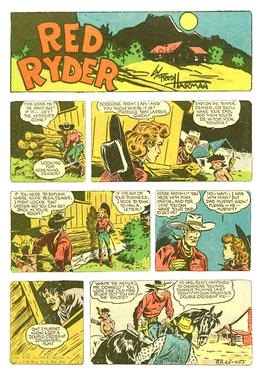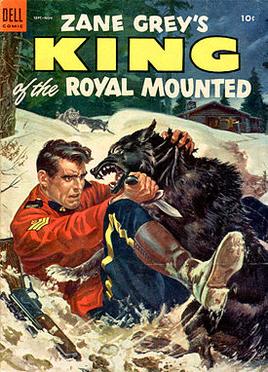Related Research Articles

Flash Gordon is the protagonist of a space adventure comic strip created and originally drawn by Alex Raymond. First published January 7, 1934, the strip was inspired by, and created to compete with, the already established Buck Rogers adventure strip.

The Phantom is an American adventure comic strip, first published by Lee Falk in February 1936. The main character, the Phantom, is a fictional costumed crime-fighter who operates from the fictional African country of Bangalla. The character has been adapted for television, film and video games.

Mutt and Jeff was a long-running and widely popular American newspaper comic strip created by cartoonist Bud Fisher in 1907 about "two mismatched tinhorns". It is commonly regarded as the first daily comic strip. The concept of a newspaper strip featuring recurring characters in multiple panels on a six-day-a-week schedule had previously been pioneered through the short-lived A. Piker Clerk by Clare Briggs, but it was Mutt and Jeff as the first successful daily comic strip that staked out the direction of the future trend.

Red Ryder was a Western comic strip created by Stephen Slesinger and artist Fred Harman which served as the basis for a wide array of character merchandising. Syndicated by Newspaper Enterprise Association, the strip ran from Sunday, November 6, 1938, through 1965.
Tailspin Tommy was an air adventure comic strip about a youthful pilot, "Tailspin" Tommy Tomkins. Originally illustrated by Hal Forrest and initially distributed by John Neville Wheeler's Bell Syndicate and then by United Feature Syndicate, the strip had a 14-year run from May 21, 1928 to March 15, 1942.
Challenge of the Yukon is an American radio adventure series that began on Detroit's WXYZ and is an example of a Northern genre story. The series was first heard on January 3, 1939. The title changed from Challenge of the Yukon to Sergeant Preston of the Yukon in September 1950, and that title was retained through the end of the series and into a television adaptation.
United Feature Syndicate, Inc. (UFS) is a large American editorial column and comic strip newspaper syndication service based in the United States and established in 1919. Originally part of E. W. Scripps Company, it was part of United Media from 1978 to 2011, and is now a division of Andrews McMeel Syndication. United Features has syndicated many notable comic strips, including Peanuts, Garfield, Li'l Abner, Dilbert, Nancy, and Marmaduke.

The Funnies was the name of two American publications from Dell Publishing, the first of these a seminal 1920s precursor of comic books, and the second a standard 1930s comic book.

Jungle Jim is the fictional hero of a series of jungle adventures in various media. The series began on January 7, 1934, as an American newspaper comic strip chronicling the adventures of Asia-based hunter Jim Bradley, who was nicknamed Jungle Jim. The character also trekked through radio, film, comic book and television adaptations. Notable was a series of films and television episodes in which Johnny Weissmuller portrayed the safari-suit wearing character, after hanging up his Tarzan loincloth. The strip concluded on August 8, 1954.

Mickey Finn was an American comic strip created by cartoonist Lank Leonard, which was syndicated to newspapers from April 6, 1936 to September 10, 1977. The successful lighthearted strip struck a balance between comedy and drama. It was adapted to a 400-page Little Big Book and was reprinted in several comic book series throughout the 1930s and 1940s.
Gaylord McIlvaine Du Bois was an American writer of comic book stories and comic strips, as well as Big Little Books and juvenile adventure novels. Du Bois wrote Tarzan for Dell Comics and Gold Key Comics from 1946 until 1971, and wrote over 3,000 comics stories over his career.

Stephen Slesinger was an American radio, television and film producer, creator of comic strip characters and the father of the licensing industry. From 1923 to 1953, he created, produced, published, developed, licensed or represented several popular literary legends of the 1920s, 1930s and 1940s.

King of the Royal Mounted (1940) is a Republic Pictures northern serial based on the King of the Royal Mounted comic strip directed by William Witney and John English.
King of the Mounties is a 1942 Republic 12-chapter film serial, directed by William Witney. Allan Lane played Sgt. Dave King of the Mounties, with Peggy Drake as heroine Carol Brent, and Abner Biberman played the villainous Japanese admiral Yamata.

Raymond S. Moore was an American comic strip artist. After Lee Falk, he was the first artist on what would become the world's most popular adventure comic strip, The Phantom, which started in 1936.

Allan "Rocky" Lane was an American studio leading man and the star of many cowboy B-movies in the 1940s and 1950s. He appeared in more than 125 films and TV shows in a career lasting from 1929 to 1966. He is best known for his portrayal of Red Ryder and for being the voice of the talking horse on the television series Mister Ed, beginning in 1961.

Western comics is a comics genre usually depicting the American Old West frontier and typically set during the late nineteenth century. The term is generally associated with an American comic books genre published from the late 1940s through the 1950s. Western comics of the period typically featured dramatic scripts about cowboys, gunfighters, lawmen, bounty hunters, outlaws, and Native Americans. Accompanying artwork depicted a rural America populated with such iconic images as guns, cowboy hats, vests, horses, saloons, ranches, and deserts, contemporaneous with the setting.
Donald Duck is an American comic strip by the Walt Disney Company starring Donald Duck, distributed by King Features Syndicate. The first daily Donald Duck strip debuted in American newspapers on February 7, 1938. On December 10, 1939, the strip expanded to a Sunday page as well. Writer Bob Karp and artist Al Taliaferro worked together on the strip for more than 30 years. The strip ended in May 1995.

Telecomics is the name of two American children's television shows broadcast from 1949 to 1951. Along with Crusader Rabbit and Jim and Judy in Teleland, the Telecomics broadcasts were some of the earliest cartoon shows on television, although they were essentially a representation of comic strips on screen, with a narrator and voice actors talking over still frames, with only occasional moments of limited animation.
References
- 1 2 3 Holtz, Allan (2012). American Newspaper Comics: An Encyclopedic Reference Guide. Ann Arbor: The University of Michigan Press. p. 227. ISBN 9780472117567.
- 1 2 "King of the Royal Mounted". Don Markstein's Toonopedia. Archived from the original on November 18, 2015. Retrieved November 17, 2015.
- ↑ Lambiek Comiclopedia. "Allen Dean".
- ↑ Lambiek Comiclopedia. "Charles Flanders".
- ↑ DuBois interview, David Anthony Kraft's Comics Interview #17 (Nov. 1984): "In 1939 I worked as a script writer on King of the Royal Mounted, when Jim Gary was doing the art work".